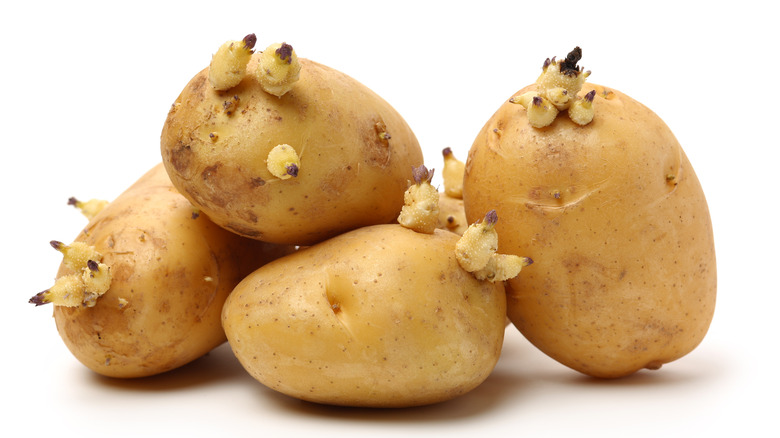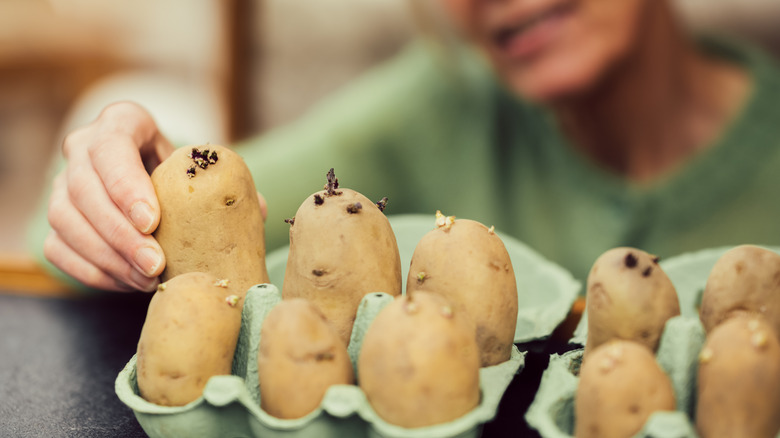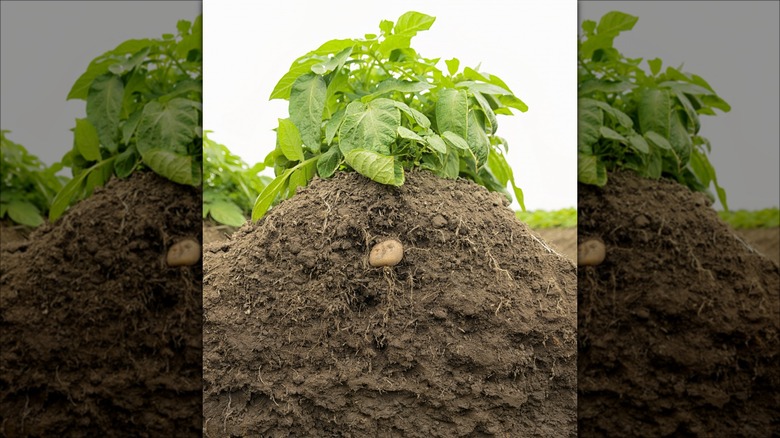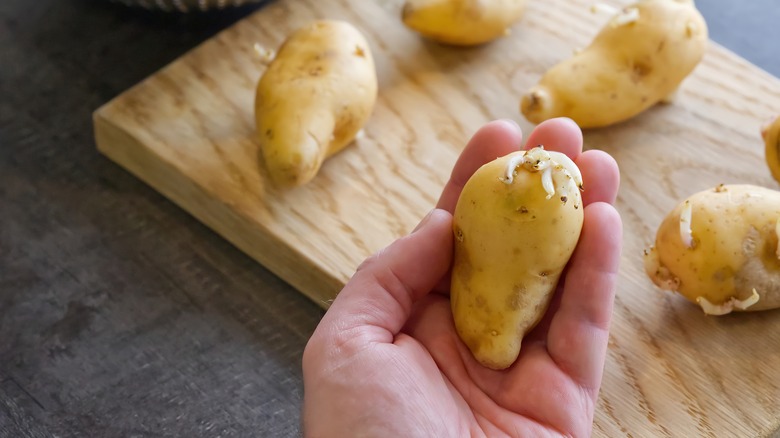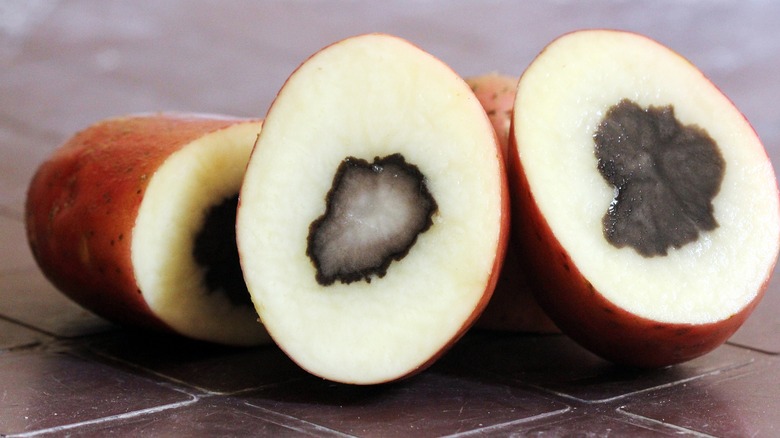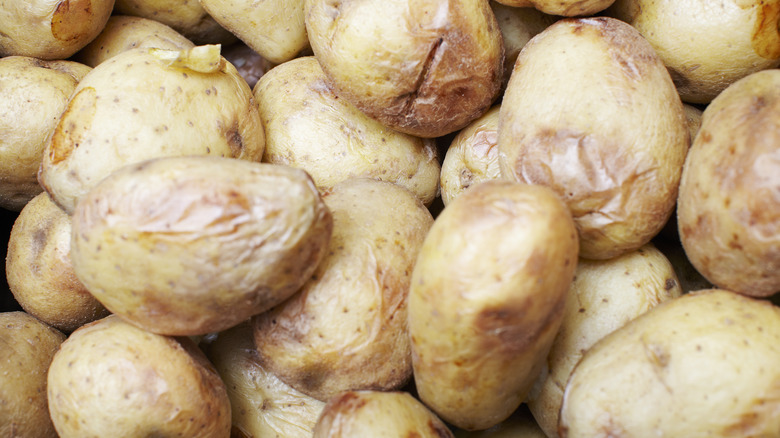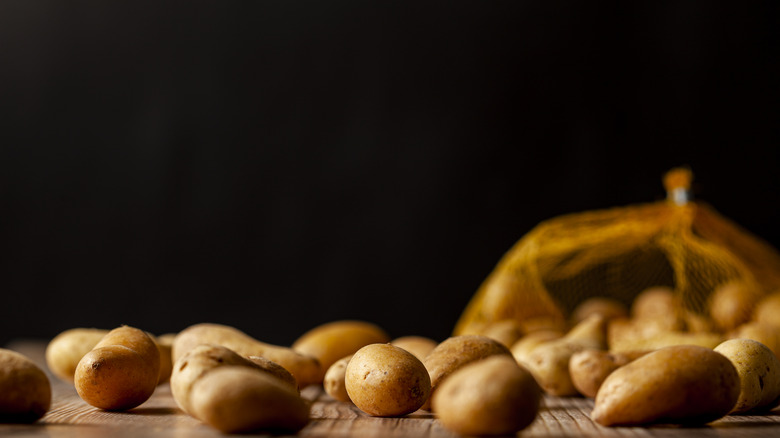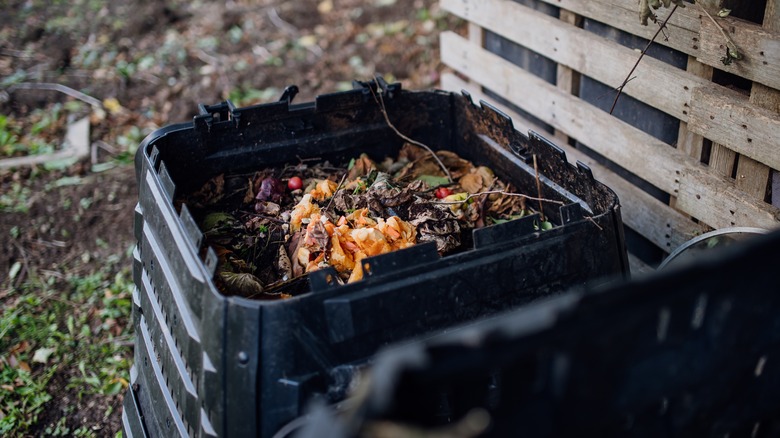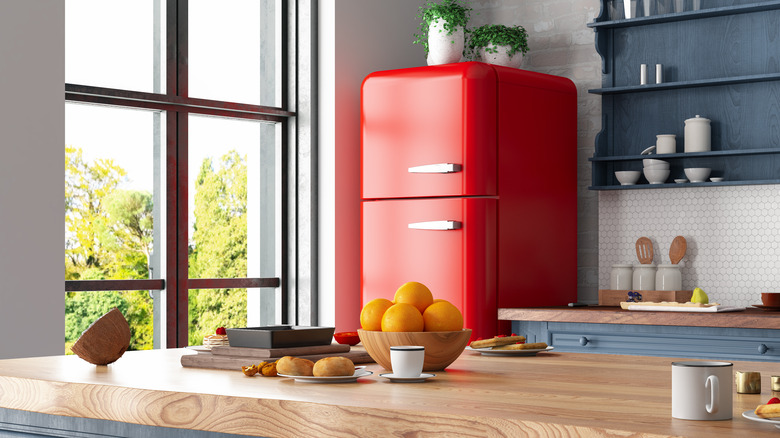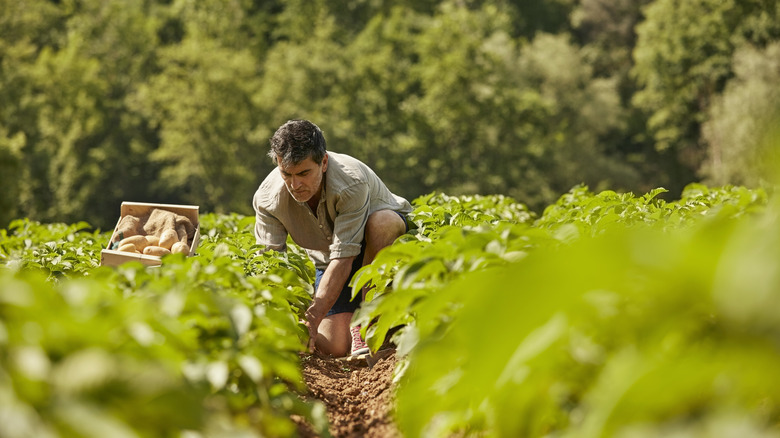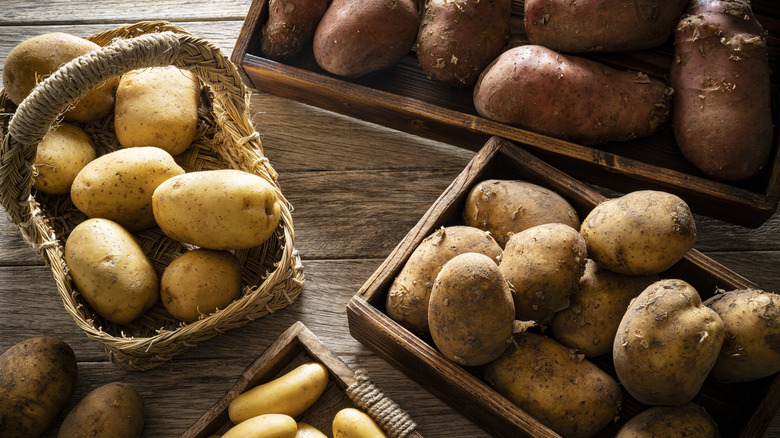Everything You Need To Know About Sprouted Potatoes
Cthulhu, that mythological creature that hatched out of the brain of H.P. Lovecraft, ain't got nothing on a sprouted potato when it comes to creepy looks. Anyone who has ever peeked inside their cupboard and saw a profusion of appendages spouting out of all sides of their potato sacks, along with the accompanying repugnant smell, would be forgiven for thinking that the potato is a miniature Cthulhu monster. In some respects, this isn't too far from the truth.
The monster in your cupboard can cause you harm in the same way that Lovecraftian horror monster can. Too much contact with said cupboard monster makes you sick. How could it not? It oozes foul juices and generally puts off a stink that rivals a stockyard. This is the sprouted potato at its worst. That said, the Cthulhu analogy really touches on the potato that is too far gone. Sprouted potatoes that are advancing in age can be harmful, but not always. Sometimes, these little monsters in the cupboards are actually salvageable if you know what to do with them.
To understand how to counteract these issues, you must look at what sprouted potatoes actually are, what causes them to sprout, whether or not you can eat them, and more importantly, when. This article answers all of these questions, as well as offers advice on how to keep your potatoes from turning into little Lovecraftian cupboard monsters in the first place.
What are sprouted potatoes?
Called eyes, these bumpy-looking nodules on your potatoes are actually the beginnings of new roots on sprouted potatoes, and they're what give sprouted potatoes their name. And just as these eyes are kind of ugly, so too are their contents: solanine and chaconine. These two substances are toxins called glycoalkaloids. They contain nitrogen and have an important function in the spud's growth process. Although they can cause humans harm if consumed, the harm factor from the potato's point of view is actually a good thing. The toxins act as deterrents for pests and microscopic organisms, like bacteria. Glycoalkaloids exist in plants in the Solanaceae, or nightshade, family, and people often ask if it's safe to eat vegetables from the nightshade family partly for this reason. Potatoes, peppers, and tomatoes are all part of this family, as is tobacco.
Weirdly, aside from having a protective mechanism, the substances also play a role in developing the good flavor of potatoes. You just shouldn't eat them as sprouts because they can make you sick if you consume them. They cause all sorts of tummy upset. If you wind up eating some of them by accident, you may find yourself wanting to spit up or spending a lot of time hanging out in the bathroom and not in a home spa bath. In light of this, it's best to enjoy the flavor they provide in the potato by eating the potato and not its sprouts.
Why do potatoes grow sprouts?
As it turns out, mankind isn't the only being that can experience seasonal confusion. Potatoes can, too, though they aren't affected by seasonal affective disorder like humans are. Instead, your potatoes make the most of their confusion by growing sprouts. For these soon-to-be tater tots and baked potato bar entrees, your practically balmy cupboard has confused them into thinking that spring has sprung. As such, for the taters, it's time to wake up from winter's slumber and grow new potato vines. Too bad those potato vines won't be growing in the rich, deep earth but rather in the bottom of your cupboard because, at least from a temperature standpoint, the conditions are right for the potatoes to start opening their wiry little eyes.
Another condition that sometimes happens simultaneously is that your potatoes will turn green. If they do, this means they have been exposed to sunlight, and chlorophyll has started infusing your potatoes with spring green. Chlorophyll itself won't harm you, but its presence does increase the amounts of toxins in the potato. Eating small amounts of a potato with green spots probably won't do you in, though it will taste pretty bitter and yucky. Large amounts, on the other hand, could harm you a great deal due to the toxic content inside the spud. In light of this, it's best to keep the spring out of the potatoes once they come to live in your cupboards.
Can you eat sprouted potatoes?
If you've ever had a potato that has grown eyes, chances are you just sliced them off and ate the potato, anyway. If so, congratulations. You're still here, meaning you did the right thing with the sprouted potato. That said, whether or not to eat sprouted potatoes isn't necessarily a hard yes or a hard no. Those who are in the camp of never-eat-this-ever contend that once the potato has grown sprouts, there are too many toxins in the potato. Because those toxins have started to disperse themselves within the potato, it's harder to cut the toxins out.
In the I-dare-you-to-do-it-anyway category are some foodies who suggest that if there's just a small amount of green and a small amount of sprouts that you can cut off, then it might be okay to eat it. The operative word here is small. Of course, this route appeals to the people who feel guilty about throwing any food out, even if it has the potential to encourage spitting up in the middle of the night.
Being daring feels good in the moment, but it is a risk, no doubt about it. Cooking the potato doesn't get rid of the toxins in the same way cooking rids foods of certain bacterial or viral dangers. So, if after reading this, you've found that you're now in the toss-it-no-matter-what column, you've probably done yourself a favor, even if it means throwing out a few spuds.
Signs that you've been poisoned by your sprouted potatoes
Poisoned by potato: It sounds like something out of a parody version of the game "Clue," like Professor Plum killed him in the dining room with a poisoned potato. However, in the world of food poisoning, this isn't a parody. In this respect, you can look at the sprouting eyes of the potatoes as warnings of possible impending doom. They're often the first sign that you'll have that the potato really should be just thrown out instead of eaten.
Most of the time, if you eat a potato that has an infusion of the toxins solanine and chaconine inside it, you'll experience various forms of gastrointestinal distress and other symptoms. These symptoms can include what you would expect. For example, you could become feverish, experience diarrhea, be plagued with a headache or vomiting, or feel dizzy, per Michigan State University. However, this doesn't touch on all the physical weirdness you can experience if you've eaten the toxins in the potato. According to Mount Sinai, potato poisoning may affect your breathing, cause hallucinations, create shock and paralysis in the body, and make for wonky vision.
And just when you thought it was safe to go back in the potato pantry, it is important to keep in mind that in the worst-case scenario, the toxins in potatoes can actually take your life, per Poison Control. Tossing the potato out may mean losing a couple of bucks, but you'll save so much more if you do throw it away, so toss it.
What else to be aware of
While potatoes might have eyes, they don't have mouths. However, that doesn't mean they don't speak to us about their state of being. You just have to know how to speak potato to determine if a spud is okay to eat. Aside from the appearance of eyes, other signs, like mold, point toward a potato that's ready for the garbage instead of the dinner table.
It's also worth saying a word or two about smell here. Most people know not to eat potatoes that smell bad. That said, a potato can be bad but still look okay. In light of that, it's a good idea to smell different parts of the potato as you pick them out. Additionally, the taste may tell you something, though if the potato's bad, that's an awful way to find out.
This is, of course, assuming that the potatoes are loose, meaning they're not in a five- or 10-pound bag. If you buy them in a bag and some of the potatoes are moldy or have a bad smell, be sure to check the potatoes around them, too. The mold and other offending materials could have contaminated the surrounding potatoes. If that's the case, those taters get tossed, too. They're definitely not ones for your potato recipes.
Bruised potatoes don't pose a threat
Despite being unsightly, bruised potatoes, as far as slightly damaged potatoes go, are actually okay to eat. Granted, you probably don't want to eat the bruised spots, but unlike when there are eyes or mold on the potato, you can cut the bruised spots out without health repercussions. In this respect, you have a bit more leeway in terms of whether or not to eat the potato than you do if the potato is sprouted. If you do wind up eating some of the bruised spots, it'll likely taste bitter, but it won't endanger your life, so there's an upside.
Sometimes, removing bruising is as simple as taking out the potato peeler and whittling away the bruised spots. At other times, you may have to carve into the potato a little bit before all of the bruised spots disappear because the bruising and dark spots are deep within the potato itself instead of just being on or below the surface.
There's one final thing you should be mindful of, however. Sometimes, dark spots don't indicate bruising but rather areas in the potato that have started to decay. In light of this, be sure to check for secondary signs of damage, like mold or dark spots. These help you to better determine whether you should eat them or not.
How to store potatoes so they don't sprout
The good news is that it's possible to prevent the Garden of Eden from growing in your cupboard if you know how to store the potatoes correctly. A breathable bag, like one made of paper or even a basket, offers some good options as anti-sprouting measures.
Going this route gives your spud some breathing room. It also puts the kibosh on moisture forming around the potatoes. Moisture plus warmth equals sprouted taters. When it comes to potato storage, a cool, dark place works best. It should have a temperature of between 45F and 55F. Because they're at the right temperature, meaning they're not immersed in too much heat, they have the potential to last in your cupboard.
On a related note, many people will store onions in the same place that they store potatoes in their pantry. If this is your tendency, it's a mistake. Both of these staple vegetables contain quite a bit of moisture. Having them in the same place in the cupboard can increase the amount of moisture that both of these vegetables are exposed to and thus cause them to go bad quicker or to sprout faster.
Things to know when composting sprouted potatoes
If your go-to response for handling vegetable peelings and cuttings consists of tossing them into the compost pile, you'll need to keep a few things in mind if you're considering throwing your sprouted potatoes in the compost pile. Not surprisingly, sprouted potatoes will continue to sprout and eventually turn into potato plants. It just makes sense. It's moist in there, packed full of nutrients, and for at least certain parts of the year, warm enough to grow a small potato patch.
Additionally, there's another thing that you need to be aware of when it comes to tossing your sprouted potatoes into the pile. If those potatoes have any kind of mold or fungus on them, it will spread to the rest of the compost pile and ruin it. This is called potato blight. Sprouts on your potatoes are a common sign, although not all sprouted potatoes will get it. When in doubt, therefore, if you're thinking about putting those potatoes in the compost pile, be sure to cut into them first. If, once you open the potato, you find that there is mold and dark spots, just put the potato in the trash instead. If you just started a composting pile (or already have one going), taking steps like this ensures your compost stays viable.
What about storing potatoes in the refrigerator?
Who knew potato storage would become the subject of such a spirited debate? But apparently, it has. Once upon a time, it was assumed that you shouldn't store your potatoes in the refrigerator. This belief stemmed from the idea that doing so would cause extra sugars to form inside the potato. This, in turn, would lead to the potatoes turning into an acrylamide factory of sorts. Acrylamide, for those not in the know, is a chemical that some studies suggest encourages cancer growth in the body. Sugar production inside the potato augments this. Or so it was thought.
This is false, or rather, further research suggests that putting your taters in the fridge won't significantly increase the amount of this chemical. Call it a scientific change of mind, if you will. This isn't to say that you cannot still store them in your cupboard if that strikes your fancy. You can, but apparently, storing them in the refrigerator allows you to keep them fresher longer, by thrice, in some cases.
It's also worth noting that it may even be better to store your potatoes in the freezer. Stashing a raw potato in the freezer means you can keep it for nearly a year. If this route appeals to you, take the time to blanch the potatoes before you put them into the freezer. This puts the kibosh on discoloration and makes them easier to cook down the road.
What can I do with sprouted potatoes?
Despite the challenges that might come with sprouted potatoes, you do have some options where they're concerned. When potatoes grow sprouts, it at least proves one thing: that they are potentially capable of growing into full-blown potato plants. For those of you who are not only food nerds but also home gardeners, this is an opportunity to add some potato plants to your garden at no cost to you.
Converting your sprouted potatoes into potato plants is a pretty simple affair. Start by cutting the sprouted potatoes into smaller bits. You want each chunk of potato to have a few eyes on them. Dig the rows in your garden. Drop the would-be potato plants into the ground in the rows, separating them by about three feet each. Leave enough headroom, so to speak, to allow for four inches of dirt on top of the sprouts. As for the sprouts themselves, when you're putting them into the ground, be sure to position them so that the eyes look up in the sky. This ensures that they grow correctly.
All of this said, if you're not feeling that ambitious, it's also perfectly okay just to throw out your sprouted potatoes. Potatoes are inexpensive, and there's no reason to save some that have gone bad. Just buy more. There's no need to grow a potato garden unless you want to.
How long can I keep potatoes that haven't sprouted?
Quite a number of factors determine the shelf life of potatoes that have yet to sprout in your cupboard or refrigerator. First of all, it will make a big difference if you buy fresh potatoes from the local farmers' market as opposed to a bag of potatoes at the grocery store. Even if the potatoes at the farmers' market are even two months old, they'll likely be younger, for lack of a better way to say it, than the potatoes you find at the grocery store.
If you are fortunate, your grocery store potatoes may only be two months old, but the fact remains they could be as old as a year. If your potatoes are older, then there is going to be less time between when you get them home and when and if they start sprouting. Some of the potatoes in the grocery store also have a spray on them that inhibits the growth of sprouts. As with most fresh produce, it's generally a good idea to eat the potatoes as soon as possible, even if it's something with the longevity of a root vegetable like potatoes.
Still, that doesn't mean that you can't take steps to preserve the potatoes that you buy. Putting them in the refrigerator or the cupboard, provided that your potato hiding place is cool and dark, allows them to be kept for one to two months on average. This is true even if you buy them at the grocery store.
